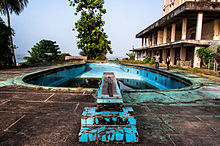Squatting in Liberia

Squatting in Liberia is one of three ways to access land, the other two being ownership by deed or customary ownership. The informal settlement West Point was founded in the capital Monrovia in the 1950s and is estimated to house between 29,500 and 75,000 people. During the First Liberian Civil War 1989–1997 and the Second Liberian Civil War 1999–2003, many people in Liberia were displaced and some ended up squatting in Monrovia. The Ducor Hotel fell into disrepair and was squatted, before being evicted in 2007. In the early 2020s, over 9,000 Burkinabés were squatting on remote land and the Liberia Land Authority (LLA) announced a plan to title all land in the country.
Overview
[edit]
Access to land in Liberia is achieved through squatting, ownership by deed or customary ownership (which does not use deeds).[1] From the 1950s onwards there have been squatted informal settlements in the capital Monrovia.[2] West Point was founded in the 1950s and is estimated to house between 29,500 and 75,000 people.[2] Many squats are beside the sea and in 2013, 200 homes in New Kru Town were washed away by a high tide.[2]
Civil wars
[edit]

During the First Liberian Civil War 1989–1997 and the Second Liberian Civil War 1999–2003, many people in Liberia were displaced and some ended up squatting in Monrovia.[3] The government charged the squatters a US$ 20 annual fee, allegedly based on the 1957 Zoning Code and although this gave no actual legal rights to land, it did mark de facto tenure.[2] The Grand Masonic Temple of the Masonic Order of Liberia was occupied by 8,000 squatters[4] and the derelict Ducor Hotel was also occupied, the inhabitants being evicted in 2007.[5] As of 2014, there were 27 squatted areas in Monrovia.[2]
The ruined former palace of politician William Tubman in the town of Harper was also squatted.[6] In the nation's second city Ganta, Gio and Mano ex-soldiers squatted following the end of conflict. They were Christian and supported Charles Taylor's faction, whereas the houses they squatted were owned by Mandinka people who were Muslim and who fought for the Liberians United for Reconciliation and Democracy (LURD), so these differences created tensions over land ownership.[7] From 2003 onwards, the local council has given squatters rights to people occupying privately owned land and the mayor herself was squatting. The mayor was forced to relinquish her own squat in 2008 and cancel the permissions, yet this has not led to evictions.[7] Around 2,000 former LURD soldiers occupied a plantation located between Monravia and the border with Sierra Leone. As of 2005, they were refusing to leave the site until the United Nations offered them retraining and they were supporting themselves financially by illegally tapping rubber.[8]
2020s
[edit]The Daily Observer reported in 2020 that over 9,000 Burkinabés were squatting on remote land in Grand Gedeh County.[9] In January 2021, the Liberia Land Authority (LLA) announced it would be digitally titling all land in the country. The Minister of Finance Samuel D. Tweah said "We should stop calling people squatters; let those squatters confer titles on squatters and let’s move on. There are too many lands here in this country; government gets plenty land".[10] In lower Margibi County, the residents of the 70-year-old informal settlement Unification Town received titles to their land in late 2020.[11]
References
[edit]- ^ Alfaro, Jose F.; Jones, Brieland (2018). "Social and environmental impacts of charcoal production in Liberia: Evidence from the field". Energy for Sustainable Development. 47: 124–132. doi:10.1016/j.esd.2018.09.004. S2CID 158551971.
- ^ a b c d e Tipple, Graham (2014). Liberia: Housing profile (PDF). Nairobi, Kenya: UN-HABITAT. ISBN 978-92-1-132626-0. Archived (PDF) from the original on 17 April 2021. Retrieved 19 April 2021.
- ^ Williams, Rhodri C. (2011). Durable Solutions and Development-Induced Displacement in Monrovia, Liberia (PDF). Norwegian Refugee Council. Archived (PDF) from the original on 17 April 2021. Retrieved 19 April 2021.
- ^ "Liberia – No More War: The Story". PBS. 2005. Archived from the original on 12 June 2018. Retrieved 17 April 2021.
- ^ Minister of Information (3 May 2007). "President Sirleaf Directs Justice Minister to Evict Squatters from Ducor". Archived from the original on 3 May 2007. Retrieved 17 April 2021.
- ^ Gordon, Glenna; MacDougall, Clair (2016). "These Abandoned Buildings Are the Last Remnants of Liberia's Founding History". Smithsonian Magazine. Archived from the original on 20 April 2021. Retrieved 17 April 2021.
- ^ a b Rincon, Jairo Munive (2010). Ex-combatants, returnees, land and conflict in Liberia. Copenhagen: CDR. ISBN 978-87-7605-383-3.
- ^ "Ex-fighters making money from latex refuse to leave rubber plantation". The New Humanitarian (in French). IRIN News. 19 April 2005. Archived from the original on 17 April 2021. Retrieved 17 April 2021.
- ^ Carter, J. Burgess (28 August 2020). "More than 9,000 Burkinabes Illegally Squatting in Grand Gedeh". Daily Observer. Archived from the original on 17 April 2021. Retrieved 17 April 2021.
- ^ Johnson, Obediah (18 January 2021). "Government of Liberia Launches Processes Leading to Digitization And Systematic Land Titling". Front Page Africa. Archived from the original on 17 April 2021. Retrieved 17 April 2021.
- ^ Kollie, Abraham K. (30 November 2020). "Margibi: Indigenous Celebrate Ownership to Land After 70 Years". KM TV News. Archived from the original on 15 April 2021. Retrieved 17 April 2021.
Further reading
[edit]- Lacey, Linda (1998). "Squatter Settlements in Liberia: Towards the Integration of Housing and Population Policies". African Urban Quarterly. 3 (3–4): 219–229.
